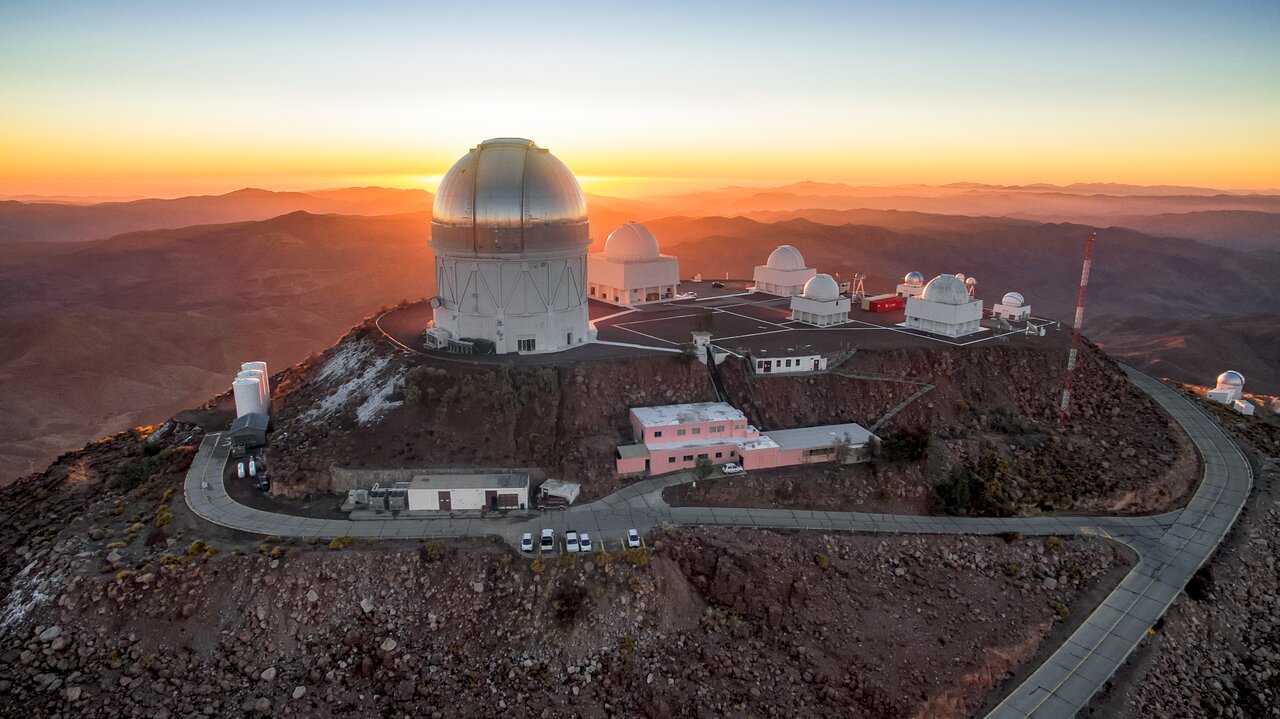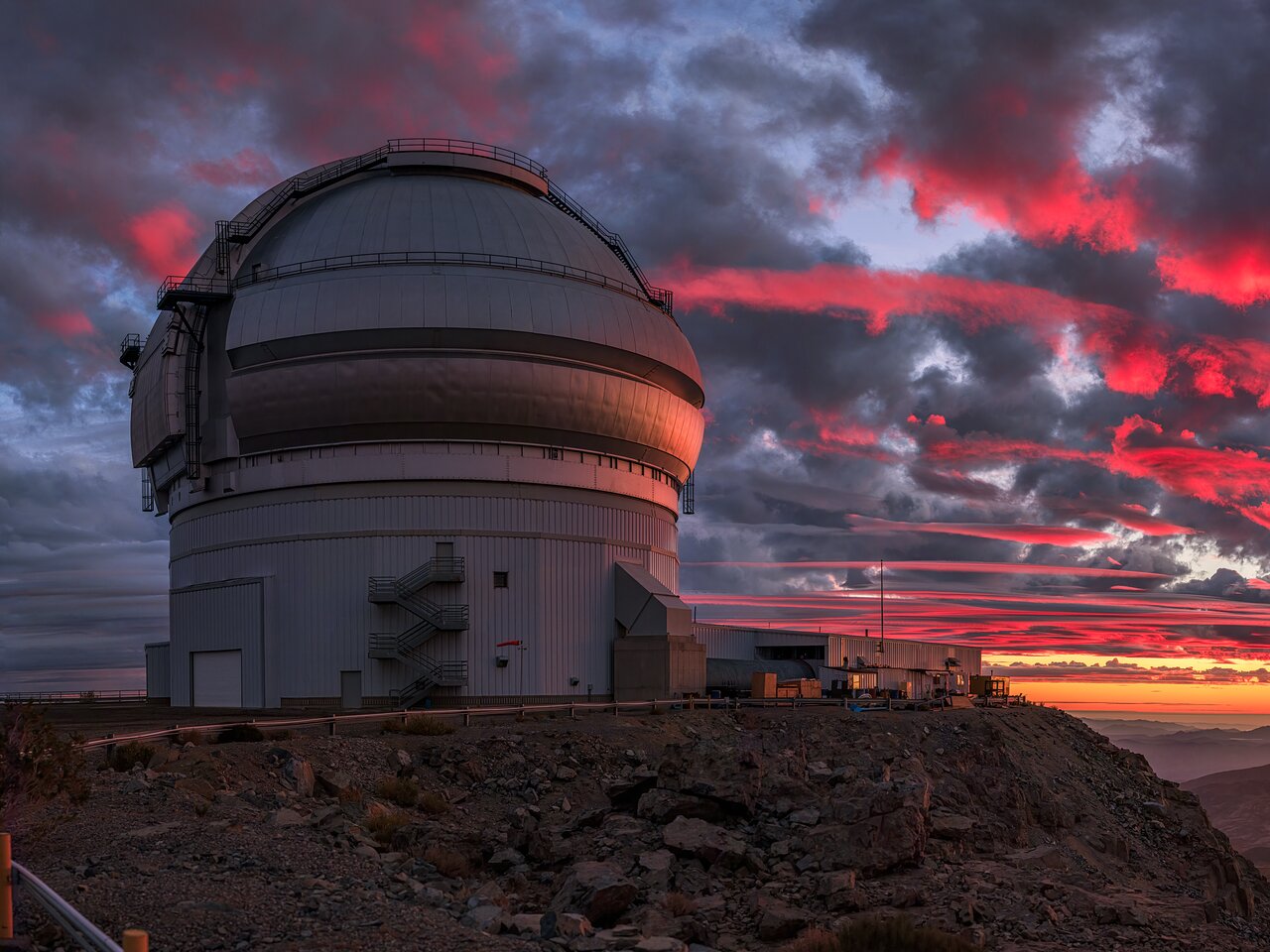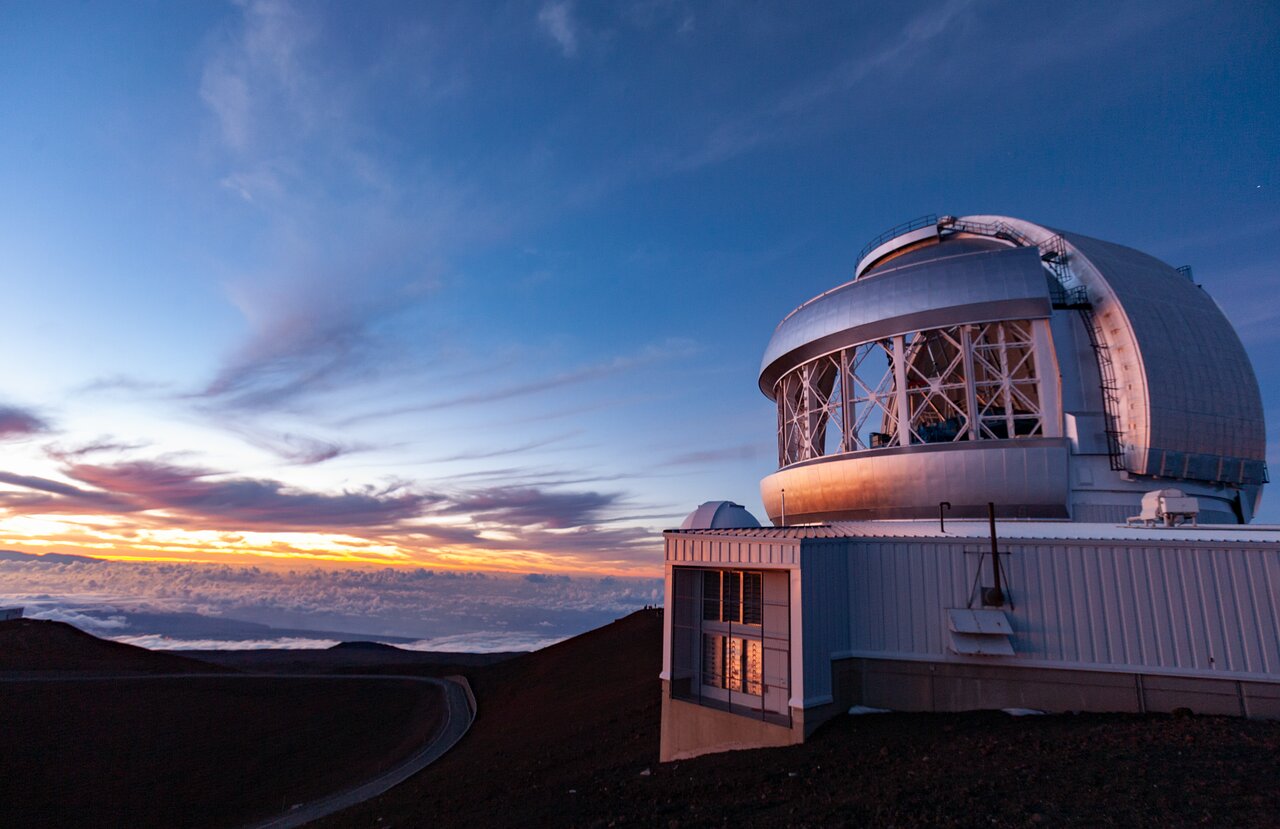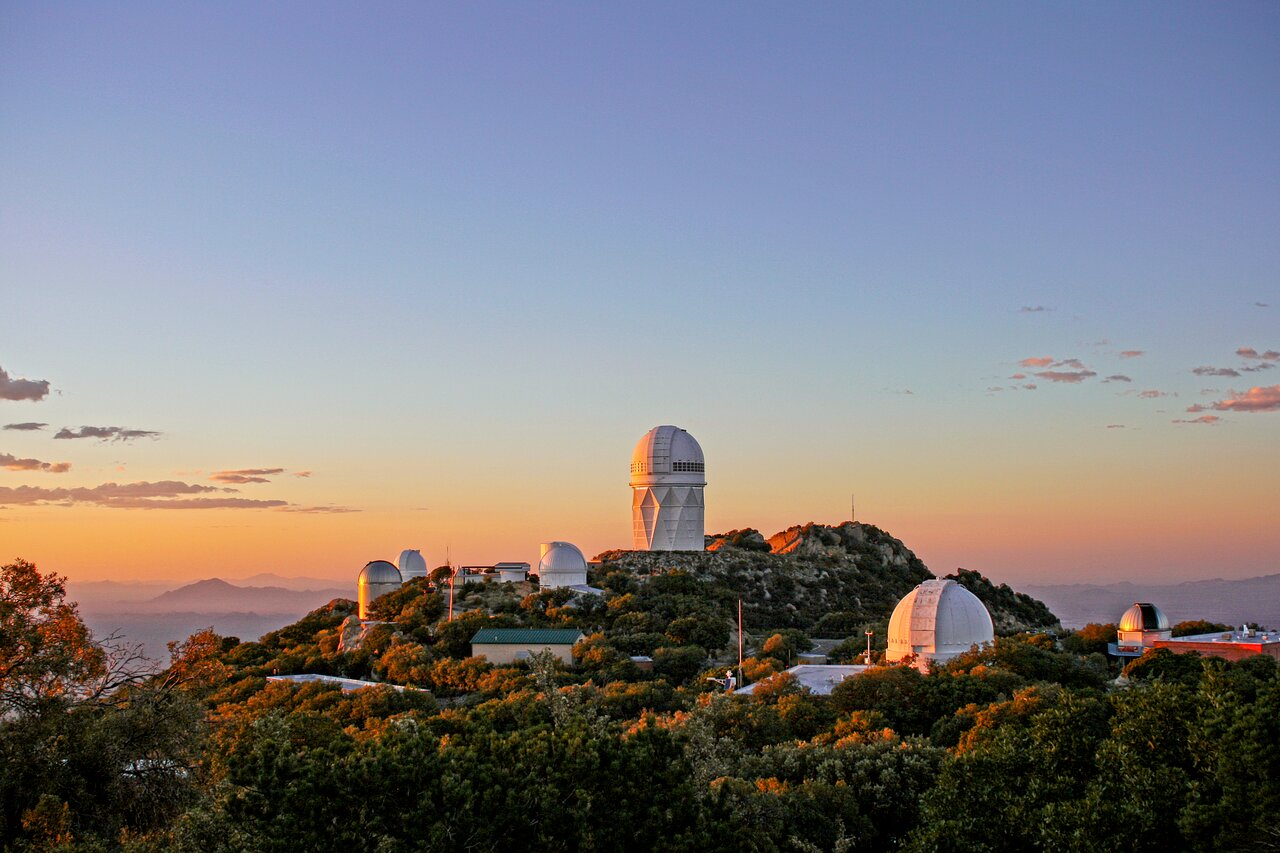
Visitas guiadas a los telescopios de NOIRLab se reanudan en julio
Las visitas públicas a algunos de los observatorios de categoría mundial de NOIRLab se están reanudando gradualmente tras interrumpirse por la pandemia, un incendio forestal y el incidente del espejo de Gemini Norte.
23 Jun. 2023
Desde el momento en que Galileo apuntó su telescopio al cielo, estos instrumentos nos han acercado a la vastedad del cosmos y su infinidad de estrellas y planetas, y desde entonces, hemos recorrido un largo camino. El avance de la tecnología nos sorprende una y otra vez, permitiéndonos descubrir en el espacio profundo objetos cada vez más extraños y exóticos de lo que podíamos imaginar.
Ahora contamos con instrumentos que pueden ver a través de masas de polvo y detectan longitudes de onda que son invisibles para el ser humano, mientras se construyen observatorios que exploran el Universo de forma aún más exhaustiva. De hecho, la ingeniería de precisión de las instalaciones modernas es tan asombrosa como el Universo que nos permite observar, y el conjunto de telescopios de categoría mundial de NOIRLab no es una excepción.
Pero estos instrumentos no sólo están destinados para los científicos; su propósito es expandir el conocimiento de la humanidad sobre el Universo en el que vivimos y nuestro lugar en él, para el beneficio de todos. Si bien los astrónomos son quienes manejan los telescopios y realizan las observaciones, la verdad es que no podrían llevar a cabo esta misión sin el apoyo del público.
Por esta razón, NOIRLab cuenta con un equipo dedicado a organizar visitas gratuitas a sus instalaciones, dando a todo el mundo la oportunidad de ver en persona algunos de los telescopios que están a la vanguardia de la investigación moderna. Después de una pausa por la pandemia de COVID-19, nuestras visitas se reanudarán este mes de julio. Además, el equipo también se encargó de rediseñar las visitas guiadas para que aproveches al máximo esta experiencia.
Leonor Opazo, que dirige el equipo de coordinación de visitas, lleva varios años trabajando en este campo y expresó su entusiasmo por volver a recibir visitas en nuestras instalaciones: “Según mi experiencia, a la gente le gusta mucho ver los telescopios donde los astrónomos hacen ciencia. Les explicamos cómo los astrónomos llevan a cabo las observaciones, para qué se utilizan los distintos instrumentos y la ciencia que hacemos. Es algo que intriga y asombra a mucha gente”, puntualizó.
Entonces, ¿qué sitio de NOIRLab te gustaría visitar?
Chile
NOIRLab opera varios telescopios en Chile, lo que permite a los astrónomos observar desde el hemisferio sur. Los telescopios se ubican en las cimas de Cerro Tololo y Cerro Pachón, lugares donde el cielo nocturno es más transparente y claro, debido a su atmósfera seca y escasa nubosidad. Para los interesados en estos lugares, a partir del 1 de julio de 2023 tendremos buses que transportarán a los visitantes desde la Garita de Acceso (ida y vuelta).
Observatorio Interamericano Cerro Tololo (CTIO): Visitas guiadas los sábados, se reanudan el sábado 1 de julio de 2023
Situado a 2.200 metros de altura en Cerro Tololo, CTIO cuenta con varios telescopios diferentes, cada uno con sus propias especialidades. Entre ellos se encuentra el Telescopio de 4 metros Víctor M. Blanco, un telescopio óptico con un espejo de cuatro metros de diámetro, que vio la luz por primera vez en 1976. En la actualidad, se utiliza junto con la Cámara de Energía Oscura, construida por el Departamento de Energía de Estados Unidos, que entre sus diferentes estudios, investiga la expansión del Universo y puede darnos pistas sobre la misteriosa energía oscura que se cree que estaría presente en todo el cosmos.
CTIO también tiene numerosos observatorios inquilinos (tenants), que ofrecen a los astrónomos de todo el mundo una observación privilegiada de los cielos del hemisferio sur.
Uno de los aspectos más destacados de las visitas guiadas a este sitio es que los visitantes pueden ingresar a la plataforma interna que rodea el telescopio de 1,5 metros, donde pueden ver cómo se abre la cúpula y se mueve el telescopio. Este telescopio vio la luz por primera vez en 1968, y en la actualidad es operado por el consorcio SMARTS (Small and Moderate Aperture Research Telescope System).
Cerro Pachón: Visitas guiadas los viernes, se reanudan el viernes 7 de julio de 2023
A unos 10 kilómetros de Cerro Tololo se encuentra Cerro Pachón, otra montaña que ofrece excelentes condiciones de observación astronómica. A 2.737 metros en lo alto de esta montaña se encuentra el telescopio Gemini Sur, la mitad austral del Observatorio Internacional Gemini, que consta de dos telescopios idénticos de 8,1 metros, uno en cada hemisferio de la Tierra. Juntos, ofrecen una visión completa de todo el cielo y contribuyen a la investigación en casi todas las áreas de la astronomía.
En Cerro Pachón también se encuentra el Telescopio de Investigación Astrofísica del Sur (SOAR por sus siglas en inglés), operado por CTIO. Al observar tanto en longitudes de onda ópticas como infrarrojas, SOAR puede capturar no sólo imágenes, sino también espectros de objetos celestes, permitiendo a los astrónomos estudiar características particulares de la luz que emiten estos objetos, y de esta forma, deducir su composición química.
Si visitas Cerro Pachón, también podrás ver algunos de los interesantes trabajos en curso del Observatorio Vera C. Rubin, actualmente en construcción. Esta nueva instalación verá la luz por primera vez en 2024 y podrá realizar investigaciones profundas que ayudarán a explorar la Vía Láctea, identificar eventos astronómicos transitorios y estudiar la materia oscura y la energía oscura.
Los tours a los sitios de telescopios de Chile volverán con una gran mejora, que es el traslado gratuíto en bus de todos los visitantes con reserva confirmada, desde la Garita de Acceso al Observatorio hasta los sitios de telescopios. Todos los detalles de esta información se pueden encontrar en nuestra página web de visitas públicas.
Recinto de AURA en La Serena: Visitas reanudadas el miércoles 7 de junio de 2023
También ofrecemos visitas gratuitas al Recinto de AURA, nuestras instalaciones base en Chile. Este Recinto se encuentra en La Serena junto al campus de la Universidad de La Serena, y alberga las oficinas del observatorio, talleres y alojamiento para los observadores visitantes.
Damos la bienvenida al público a estas instalaciones, con visitas que incluyen charlas sobre temas astronómicos y el trabajo que realiza el personal del observatorio en este lugar. Estas visitas son ideales para grupos de estudiantes.
Hawai‘i
Telescopio Gemini Norte: Visitas guiadas los jueves, se reanudan el jueves 6 de julio de 2023
La mitad boreal del Observatorio Internacional Gemini, el telescopio Gemini Norte, está situado en Maunakea (Hawai‘i). El lugar ofrece algunos de los puntos de observación más prístinos del cielo nocturno, lo que lo convierte en un lugar popular para los astrónomos. Además, Gemini Norte se ubica entre una colección de otros telescopios operados por diversas organizaciones internacionales.
El Observatorio Gemini es líder mundial en óptica adaptativa, una técnica que se utiliza para corregir errores en las observaciones causados por la atmósfera terrestre. Para ello, los telescopios dirigen láseres hacia el cielo y analizan la luz que se refleja para comprender cómo la distorsiona la atmósfera. Estas visitas se realizan durante el día, pero si miras hacia la montaña por la noche, podrás ver a lo lejos el impresionante láser surcando el cielo.
Acabamos de reanudar las visitas públicas al Telescopio Gemini Norte en Maunakea. Reserva aquí tus entradas gratuitas.
Instalaciones Base de Gemini Norte, Hilo: Visitas guiadas el primer viernes de cada mes, reanudadas el viernes 2 de junio de 2023.
Las Instalaciones Base de Gemini Norte están situadas en Hilo, Hawai‘i, y desde allí, el telescopio Gemini Norte se opera de forma totalmente remota. Esta capacidad de operación remota hace que los telescopios Gemini sean únicos entre la clase de telescopios de 8-10 metros. Acabamos de reanudar las visitas públicas a las Instalaciones Base de Gemini Norte. Reserva aquí tus entradas gratuitas.
Tucson, Arizona
Sede Central de NOIRLab en Tucson: Las visitas guiadas comenzaron el viernes 2 de junio de 2023
La Sede Central de NOIRLab de NSF se encuentra en Cherry Avenue de Tucson (Arizona), cerca del campus de la Universidad de Arizona. Justo enfrente de la sede se encuentra el Observatorio Steward de la Universidad de Arizona.
Las visitas guiadas ofrecen un recorrido por las oficinas de este edificio: El vestíbulo de NOIRLab, donde los visitantes se registran con la recepcionista al comienzo de su visita; el patio interior, una zona al aire libre donde el personal de NOIRLab puede leer, almorzar o celebrar pequeñas reuniones informales; la Biblioteca de la Sede Central de NOIRLab, con diverso material de referencia, como una colección física de libros y revistas relacionados con la astronomía, la tecnología y campos afines; y el taller mecánico, en funcionamiento desde 1960, con tornos de máquinas, fresadoras, taladros y rectificadoras, algunas dirigidas por control numérico computarizado (CNC por sus siglas en inglés).
Observatorio Nacional Kitt Peak (KPNO) y Centro de Visitas: Sólo abierto para el Programa de Observación Nocturna con Telescopios
KPNO está situado a 2.096 metros de altitud en la montaña Iolkam Du'ag (Kitt Peak), en el distrito de Schuk Toak, en la Nación Tohono O'odham. Opera varios telescopios, entre ellos el Telescopio de 4 metros Nicholas U. Mayall –conocido por haber descubierto hielo de metano en Plutón– y el telescopio WIYN de 3,5 metros, cuyo instrumento NEID es un cazador de exoplanetas de última generación. KPNO también alberga más de una docena de telescopios operados por diversos consorcios internacionales.
Cerca de KPNO se encuentra el impresionante Centro de Visitas que ha inspirado a los visitantes desde su creación en 1964.
Desgraciadamente, la reapertura al público de KPNO y del Centro de Visitas se ha retrasado debido al impacto del incendio Contreras que ocurrrió a mediados de 2022. El Departamento de Transportes de Arizona sigue trabajando en la carretera pública que lleva al observatorio y sólo se abrirá cuando se instalen nuevas barandas de contención, entre otras reparaciones.
Mientras la carretera a Kitt Peak sigue cerrada, estamos reabriendo gradualmente el exclusivo Programa de Observación Nocturna con Telescopios. Este programa personalizado ofrece la experiencia completa de un observatorio y permite que hasta cuatro personas tengan una experiencia como astrónomos visitantes en Kitt Peak.
Para reservar una de nuestras visitas, ingresa a la nueva página web de visitas, donde encontrarás información sobre las actividades y el sistema de reservas en línea. El sitio web también contiene enlaces a diversos recursos, como mapas de los sitios e información sobre los distintos telescopios y sus instrumentos, por si deseas información antes de visitarnos. También encontrarás un enlace a los tours virtuales de los observatorios, para que puedas explorarlos desde cualquier parte del mundo.
--
No te pierdas nuestras últimas noticias en nuestros canales de redes sociales, así podrás enterarte de las fechas de nuestras actividades, o suscríbete a nuestra cuenta de Eventbrite para que te avisemos cuando publiquemos nuevos eventos.
Observatorio Nacional Kitt Peak: Facebook, Twitter
Observatorio Interamericano Cerro Tololo: Facebook, Twitter
Observatorio Internacional Gemini: Facebook, Twitter, Instagram
NOIRLab: Facebook, Twitter, Instagram
NOIRLab en español: Facebook, Twitter, Instagram
¡NOIRLab espera recibirte nuevamente en el mundo de la astronomía!
Enlaces
- Visitas Públicas
- Visita Cerro Tololo, Chile
- Visita Cerro Pachón, Chile
- Visita el Recinto de AURA, Chile
- Visita Gemini Norte, Hawai‘i
- Visita las Instalaciones Base de Gemini Norte, Hawai‘i
- Visita la Sede Central de NOIRLab, Arizona
- Programa de Observación Nocturna con Telescopios de KPNO
- Tours Virtuales
- Anuncio actualizado sobre visitas







